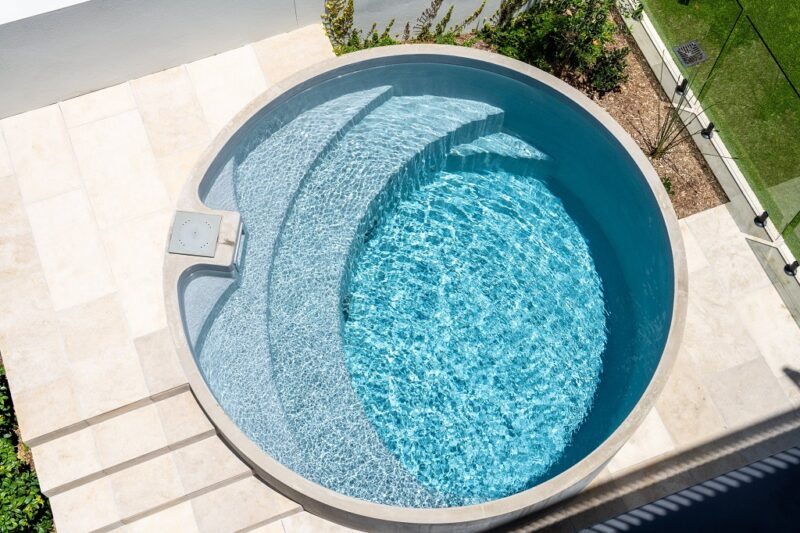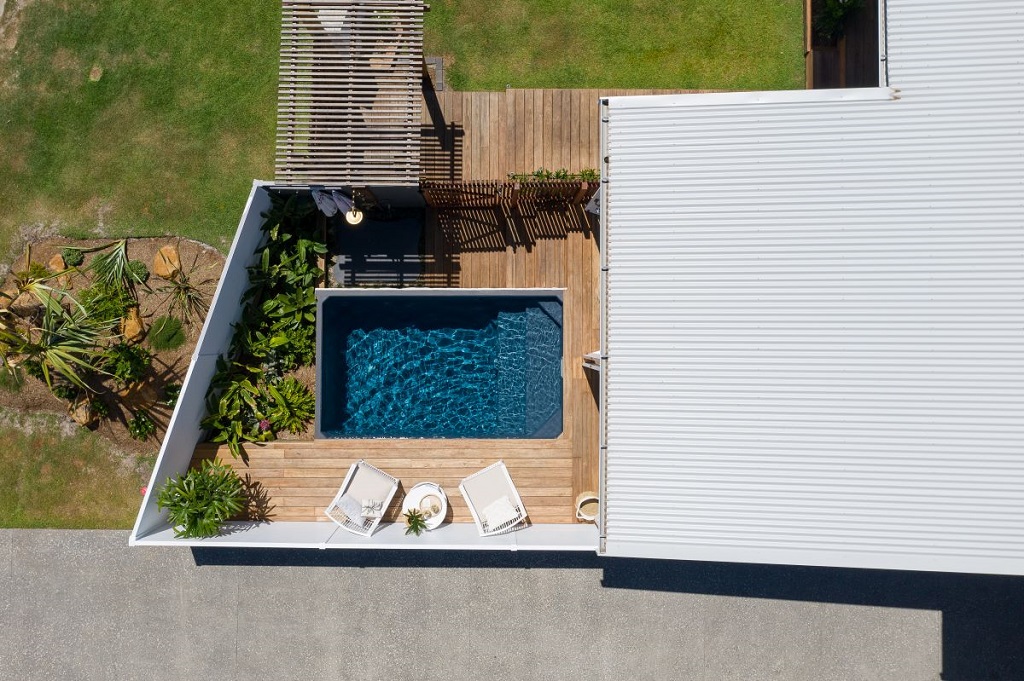Plungie pools, also known as plunge pools, are small pools designed for taking a quick dip to cool off on hot days. Their compact size makes them a popular backyard pool option. But how deep should a plungie pool be to be safe and usable? When installing one of these small swimming pools, let’s look at plungie pool depths and other factors.
What is a Plungie Pool?
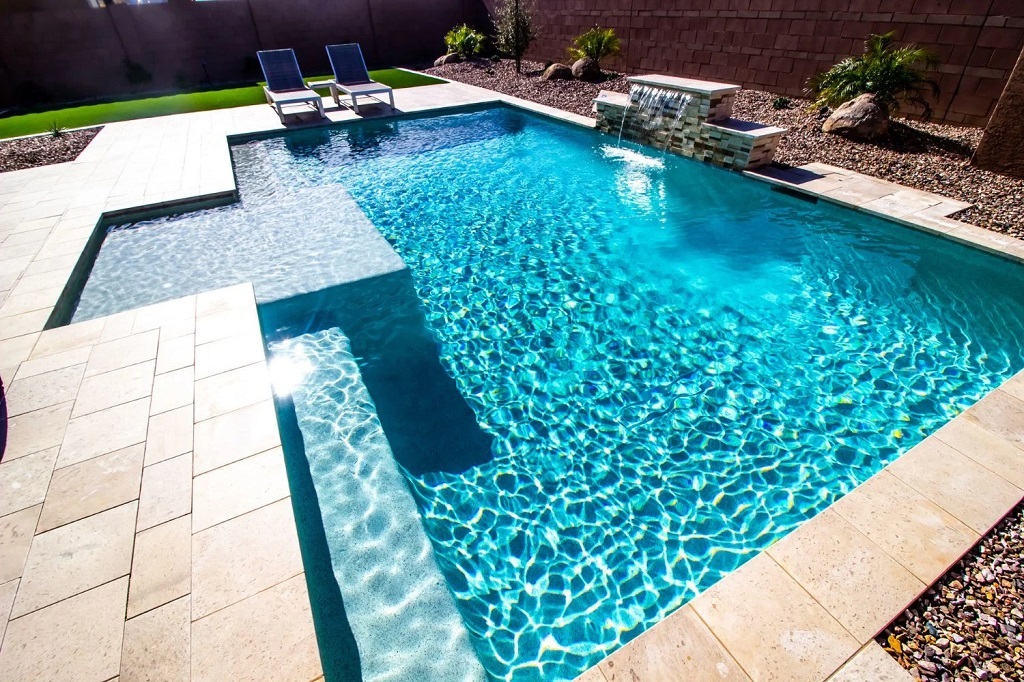
A plunge pool, sometimes spelled plunge or plunge pool, is a small, in-ground or above-ground pool designed for descending rapidly into the water to cool off, essentially to take a “plunge.”
Plungie pools are much shallower than traditional ones, averaging only 2-4 feet deep. Their small size, typically 8-12 feet in diameter, allows them to fit in urban backyards or tight spaces where a larger pool isn’t feasible.
These petite pools are not made for swimming laps or playing pool games. Their sole purpose is brief immersion to cool down on hot days quickly. For this reason, plungie pools, also referred to as dipping pools or soaking Plungie Pools, are an excellent addition to any outdoor space. Many homeowners might be curious about the plungie pool cost installed, considering their compact size and specific use.
Typical Plungie Pool Depths
Most plungie pools range from 2-4 feet in depth. Here are some common plungie pool depth measurements:
- 2 feet deep: The minimum recommended depth for a plungie pool. The pool is more for sitting in than plunging at this shallow depth. It’s a good choice for cautious swimmers.
- 3 feet deep: A standard compromise depth suitable for plunging while still safe for less experienced swimmers. Most adults can fully immerse themselves up to their necks at this depth.
- 4 feet deep: The maximum recommended plungie pool depth. This allows enough depth for an adult to plunge into their shoulders. Any deeper is not necessary, given the pool’s small diameter.
Plungie pools deeper than 4 feet become potentially dangerous for unwary swimmers due to the risk of diving accidents. For this reason, most residential building codes prohibit plungie pools deeper than 4 feet.
When deciding on the most appropriate depth for your plungie pool, keep these key factors in mind:
Swimming Ability
Consider the swimming capabilities of the adults and children using the plungie pool. Beginner swimmers may be better off with a 2-3 foot shallow pool. Weaker swimmers can keep their heads above water in shallower depths. Meanwhile, experienced adult swimmers may prefer a plunging depth of 3-4 feet. Adjust the depth based on your family’s comfort level.
Pool Floor Shape
The pool floor can be flat, sloped, or tiered from shallow to deep areas. A sloped floor provides a gradual depth transition. Tiered pools have one or more bench areas for sitting in the shallow end. Choose a pool floor design suited to your desired plunging, soaking, and lounging activities.
Pool Access
Factor in how pool users will enter and exit the plungie pool. Integrated steps, ladders, or benches make getting in and out of the pool easier. Position steps in the shallow area if the pool depth exceeds 3 feet. Ease of access is essential for pools used by kids, seniors, or anyone with limited mobility.
Pool Usage
Think about your intended activities in the plungie pool besides plunging and cooling off. For leisurely soaking, a shallower depth of around 2 feet may suffice. If you want to immerse your entire body, consider a 3-4 foot plunging depth. And add extra depth if you plan to install underwater pool seating.
Safety Features
No matter the depth, plunge pools should be equipped with safety features like non-slip surfaces, grab rails, and a fence with a self-closing gate. These details become even more critical with maximum depths over 3 feet. Diving and jumping should be prohibited, given the risks in a small pool.
Local Building Codes
Most residential pools are limited to a maximum depth of 4 feet. Some codes only allow portable plungie pools up to 2 feet deep before classifying them as permanent pools. Check your local ordinances for relevant depth and safety regulations.
Pool Structure: In-Ground vs. Above-Ground
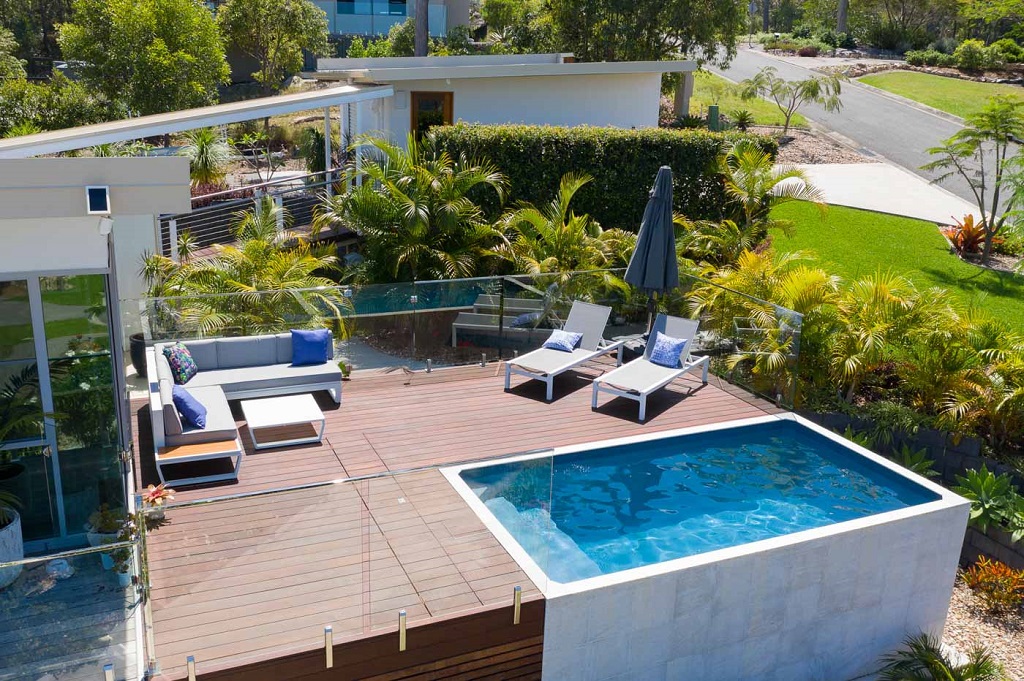
Plungie pools can either be installed in-ground or situated above-ground:
In-ground plungie pools are dug into the yard like standard pools. This permanent installation has a more significant upfront cost but provides a seamless look. In-ground plungie pools are typically 3-4 feet deep.
Above-ground plungie pools are installed on top of the ground, like a hot tub. They are quicker to set up and cost less initially. But they take up more surface space in the yard. Above-ground plungie pools range from 2-4 feet in depth.
Above-ground pools are sometimes portable, allowing you to take them down for the winter in cold climates. But they may be subject to stricter depth regulations than permanent in-ground pools.
Ideal Dimensions for Plungie Pools
Beyond depth, plungie pools are defined by their cozy dimensions. Small size distinguishes them from sizeable in-ground swimming pools.
Typical plungie pool diameters range from 8-12 feet across. Their compact circular or square/rectangular footprints allow them to tuck into tight backyard spaces.
For context, a standard lap pool is at least 20-25 feet wide and 30-50 feet long. So plungie pools take up a fraction of the surface area occupied by a regular swimming pool.
Some key factors to consider when choosing plungie pool dimensions:
- Amount of yard space available
- Number of regular users (ideally 2-4 people max at once)
- Desired plunge entry space (5-6 feet minimum)
- Room for steps, benches, and accessories
- Local backyard pool codes
As long as you have at least 8 feet of clear plunge space, a plungie pool can be tailored to your specific yard dimensions and usage needs.
Plungie Pool Design Variations
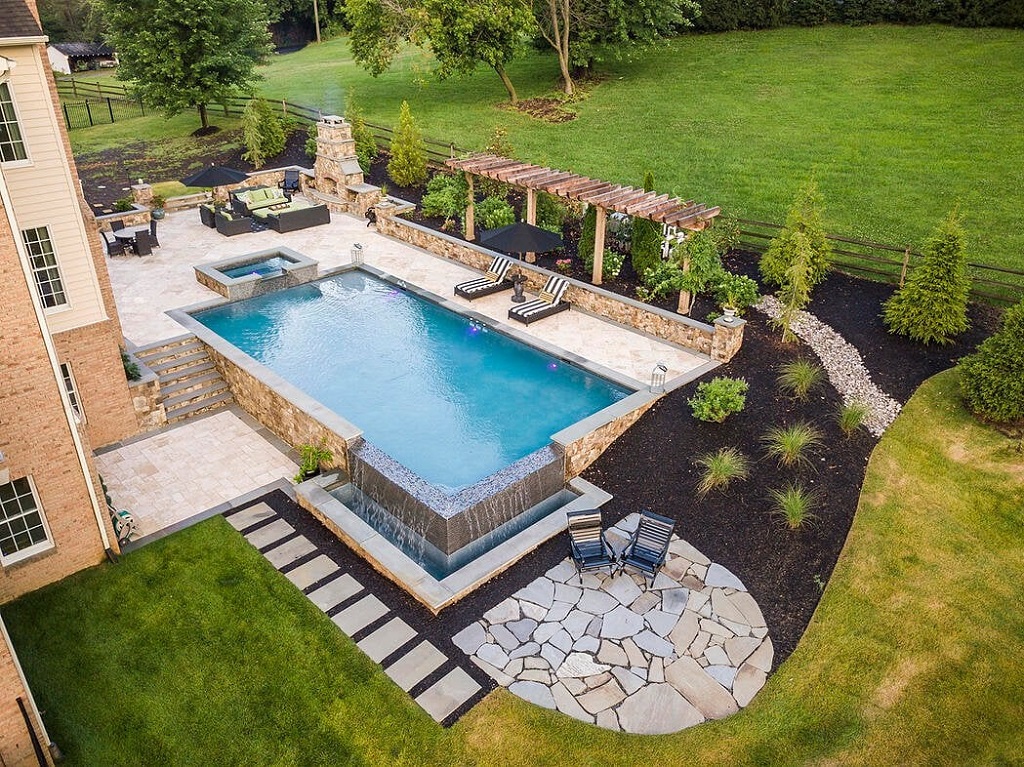
While mainly utilitarian in purpose, plungie pools can also reflect your sense of style through material and design choices:
- Formal pools have geometric shapes, clean lines, and concrete or tile finishes for an elegant backyard look.
- Natural pools mimic ponds with organic freeform shapes, rock elements, and simulated beach entries.
- Infinity pools have one side that overflows for dramatic views. These work best on properties with scenic vistas.
- Raised pools are installed on decks or patios above ground level. This style is excellent for rooftop and balcony spaces.
- Tiered pools feature a shallow bench area for lounging and one or more descending steps to deeper soaking depths.
No matter what design fits your space and taste, focus first on creating a comfortable soaking depth and safe entry/exit routes. Visually stunning plungie pools still need to function flawlessly.
Benefits of Plungie Pools
Why should you consider installing a plungie pool instead of a full-size one? Here are some of the biggest benefits that make them a popular backyard upgrade:
Compact Size
Plungie pools only need a small footprint of 8-12 feet across, allowing them to fit in urban backyards and tight spots where larger pools won’t work. Their shallow depth also reduces the amount of ground excavation required.
Quick Cool-Off
You can dip in and out of a plungie pool in minutes to rapidly cool down after yardwork or sunbathing on hot days. There’s no need to carve out hours of pool time.
Soothing Soaks
While designed for quick plunges, plungie pools also invite longer soaking sessions. Their cozy dimensions create a comfortable spa-like environment for two or three people.
Easy Maintenance
The small water volume and surface area require fewer chemicals and cleaning than full-size swimming pools. Many plungie pools even come with simple cartridge filtration systems.
Affordable Cost
Plungie pools have lower installation costs than traditional in-ground pools. Above-ground models are the most budget-friendly option. The petite size also reduces water usage and heating expenses.
Intimate Ambiance
Unlike big, shared swimming pools, plunge pools have an intimate, almost romantic feel perfect for couples or close families. Their enclosed design also offers privacy.
For all these reasons, plungie pools deliver maximum refreshment and relaxation value from minimal yard real estate. Their cozy plunge-ability makes them ideal for urban and modern lifestyles.
FAQs About Plungie Pools
Here are answers to some frequently asked questions about plungie pool depths, sizes, costs, and more:
How deep should a plungie pool be?
Most plungie pools range from 2-4 feet deep. Shallower depths of 2-3 feet are best for beginner swimmers. For full-body plunging, consider 3-4 feet deep.
What size is the average plungie pool?
Plungie pools commonly measure 8-12 feet in diameter. This compact circular size can fit most urban backyards while allowing enough room to plunge in. Rectangular plungie pools may be 8×12 feet or 10×10 feet.
How much does a plungie pool cost?
A primary above-ground plunge pool starts at around $3,000. More elaborate designs with water features or infinity edges can cost $6,000-$10,000. Built-in in-ground plunge pools begin at about $15,000. Operating costs are low thanks to their small volume.
Can you swim laps in a plungie pool?
No, deep plungie pools are too small for swimming laps. There is only enough space to take a quick plunge or soak. It would be best to have a pool at least 25-30 feet long and 5 feet deep for lap swimming.
Are plungie pools safe?
Plungie pools are safe with proper safety measures like non-slip surfaces, fences, no diving warnings, and child supervision. Their shallow depth reduces injury risks. Proper disinfection and maintenance are also crucial.
Can you heat a plungie pool?
Yes, plungie pools can be heated using electric or solar heaters. Their small water volume means they heat up quicker and for less cost than larger pools. Maintaining temperatures of 80-90°F extends usage in cooler weather.
Conclusion
Plungie pools offer an enticing backyard solution for urban homeowners seeking a private oasis to relax and cool off without the space demands of a big swimming pool. By tailoring the dimensions and depth to your needs, you can create the perfect plunging experience. Sizing from 8-12 feet across and 2-4 feet deep allows for refreshing dips whenever you need a quick escape from the summer heat. Discovering how to find a leak in a pool liner is essential for maintaining the allure of deep plungie pools, where their combination of petite size and maxi enjoyment offers five-star plunging experiences on a one-star budget.

